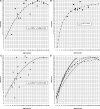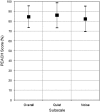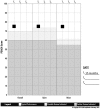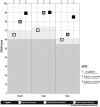The University of Western Ontario Pediatric Audiological Monitoring Protocol (UWO PedAMP)
- PMID: 22194316
- PMCID: PMC4040831
- DOI: 10.1177/1084713811420304
The University of Western Ontario Pediatric Audiological Monitoring Protocol (UWO PedAMP)
Abstract
This study proposed and evaluated a guideline for outcome evaluation for infants and children with hearing loss who wear hearing aids. The University of Western Ontario Pediatric Audiological Monitoring Protocol (UWO PedAMP) was developed following a critical review of pediatric outcome evaluation tools and was systematically examined by the Network of Pediatric Audiologists of Canada. It consists of tools to gather clinical process outcomes as well as functional caregiver reports. The UWO PedAMP was administered to a clinical population of infants and children with hearing aids. Sixty-eight children were administered the functional outcome evaluation tools (i.e., caregiver reports) a total of 133 times. Clinical process outcomes of hearing aid verification (e.g., real-ear-to-coupler difference) revealed typical aided audibility (e.g., Speech Intelligibility Index). Results for the LittlEARS(®) questionnaire revealed that typically developing children with hearing loss who wear hearing aids are meeting auditory development milestones. Children with mild to moderate comorbidities displayed typical auditory development during the 1st year of life after which development began to decline. Children with complex factors related to hearing aid use had lower scores on the LittlEARS, but auditory development was in parallel to norms. Parents' Evaluation of Aural/Oral Performance (PEACH) results indicated no age effect on scoring for children above 2 years of age; however, the effect of degree of hearing loss was significant. This work provides clinicians with a systematic, evidence-based outcome evaluation protocol to implement as part of a complete pediatric hearing aid fitting.
Conflict of interest statement
Figures
















References
-
- American Academy of Audiology. (2003, October). Pediatric amplification protocol. Retrieved August 18, 2011 from http://www.audiology.org/resources/documentlibrary/Documents/pedamp.pdf
-
- American National Standards Institute. (1997). Methods for the calculation of the Speech Intelligibility Index (ANSI S3.5–1997). New York, NY: Acoustical Society of America
-
- Andresen E. M. (2000). Criteria for assessing the tools of disability outcomes research. Archives of Physical Medicine & Rehabilitation, 81(Suppl. 2), S15-S20 - PubMed
-
- Bagatto M. P., Brown C. L., Moodie S. T., Scollie S. D. (2011). External validation of the LittlEARS® auditory questionnaire with English-speaking families of Canadian children with normal hearing. International Journal of Pediatric Otorhinolaryngology, 75, 815-817 - PubMed
Publication types
MeSH terms
Grants and funding
LinkOut - more resources
Full Text Sources
Medical
